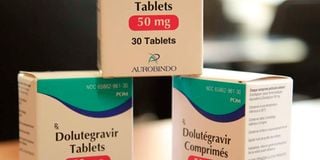Scientists endorse new drug for second-line HIV treatment

What you need to know:
- The recommendation is based on evidence that DTG is cheaper, easy to use and has less drug interactions compared to the currently used regimens.
- Kenya has the fourth largest HIV burden in the world with about 1.4 million people living with HIV. Of these, just over 1.1 million are on antiretroviral therapy (ART).
A team of researchers have recommended the use of a new antiretroviral therapy (ART) as a second-line treatment for HIV positive patients.
According to the researchers, patients should be put on dolutegravir (DTG) even without testing them for resistance to other HIV drugs. Patients are normally put on second line treatment after developing resistance to the first-line ARTs.
The recommendation is based on evidence that DTG is cheaper, easy to use and has less drug interactions compared to the currently used regimens.
Kenya has the fourth largest HIV burden in the world with about 1.4 million people living with HIV. Of these, just over 1.1 million are on antiretroviral therapy (ART).
Although current national guidelines recommend the use of Atazanavir / ritonavir or Lopinavir / ritonavir-based regimen (ATV/r or LPV/r) as second line treatment, the experts argue that the treatment known as Protease inhibitors (PIr) are not only associated with side effects such as an increase in cardiovascular disease risk but also have significant drug to drug interactions that complicate management of other conditions such as tuberculosis.
Patients on ARTs are advised to go for a viral load test, which measures how much human immunodeficiency virus (HIV) is in their blood. The test measures the number of HIV copies in a milliliter of blood and helps the doctor follow what is happening with an individual’s infection, how well the current treatment is working, and guide treatment choices for the patient. Once on regular ARTs and the viral load is undetectable, the test is done every six to 12 months for monitoring purposes.
It is this test that will alert the doctor whether there is need to switch the regimen of treatment or not. Newly tested HIV patients are put on first-line treatments. However, when the first-line treatment fails, they are moved to second-line regimens.
The World Health Organization (WHO) recommends the use of dolutegravir as the preferred first-line and second-line treatment for all populations, including pregnant women and those of childbearing potential. In Kenya, DTG was introduced at the end of 2017 with the first delivery of the fixed dose combination.
On the other hand, protease inhibitors (PIr) are antiviral drugs used for treating human immunodeficiency virus (HIV) infection. But these PIr pills are highly toxic, costly and may not be well tolerated and may involve a high pill burden in patients. Worse still, in patients with other comorbidities such as cancer or Tuberculosis, these drugs can cause a reaction between two (or more) drugs.
For this reason, the authors argue that switching patients with suppressed viral load from a PIr based second-line treatment to a DTG based regimen is better.
“DTG is a safer, better, and easier treatment and should be the preferred second line regimen,” explained Dr Loice Ombajo, the lead author of the study presented at the conference on retroviruses and opportunistic infections (CROI).
The study involved 791 adult participants. Some 397 were put on DTG while the rest were on the protease inhibitors. The participants, enrolled between February and September 2020 and followed up for 11 months, were in four sites located in Nairobi, Kiambu and Kisumu counties.
“This study demonstrates the critical nature of switching an HIV treatment regimen in a Kenyan cohort to one based on dolutegravir that would save lives without increasing costs. This would then result in an increase in the life expectancy of people living with HIV in Kenya and a decrease in new HIV infections with a minimal impact on the country's HIV/AIDS budget,” said Dr Marianne Mureithi, a medical microbiologist at College of Health Sciences, University of Nairobi.
Both drugs controlled HIV well but patients on ATV/r or LPV/r had higher cholesterol compared to those put on DTG. But Dr Ombajo explained that switching from the current second-line treatments may not be done immediately because “it involves the logistics of ensuring sufficient stocks of DTG are available for all patients who are currently on second line".”
“Patients are advised to discuss the treatment options available to them with their health care provider,” she added.





